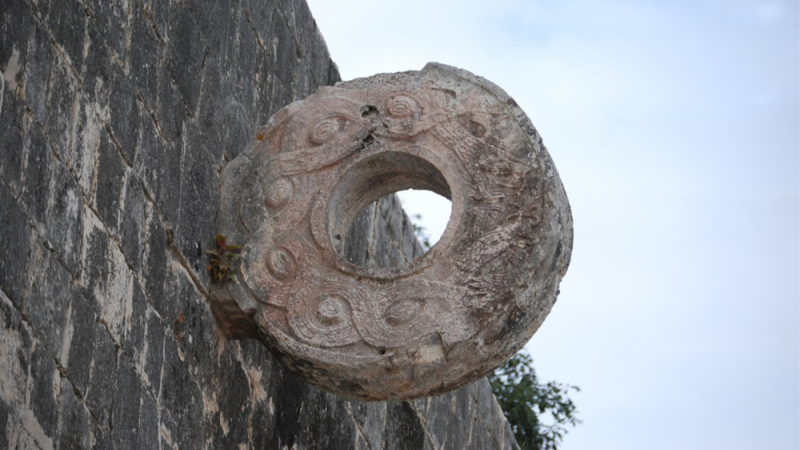Plants detected in ancient Mayan ‘ballcourts’ point to a sacred spot

Archeologists have found evidence that ancient Mayans may have made ceremonial offerings during the construction of the ballcourts they used for sporting events. An international team of researchers used advances in environmental DNA (eDNA) analysis to detect evidence of several plants known for both medicinal and religious purposes. The microscopic fragments of ancient plants were found beneath the floor of a Mayan ballcourt in present day Mexico and are described in a study published April 26 in the journal PLOS One.
The research was a collaboration of Mexico’s National Institute of Anthropology and History in collaboration with researchers from the University of Cincinnati in the United States, the University of Calgary, in Canada, Mexico’s Autonomous University of Campeche and the National Autonomous University of Mexico.
Play ball
From 2016 to 2022, the team excavated ruins of the ancient city of Yaxnohcah–formerly major city is in the present day Mexican state of Campeche, near the border of Guatemala. The structure in the study was originally constructed sometime between 1000 and 400 BCE. It was subsequently remodeled around 400 BCE-200 CE, when a ballcourt was added.
According to the team, the ancient Maya participated in several ball games. One included pok-a-tok, a mix of soccer and basketball that is undergoing a revival. Players likely tried to get a ball through a ring in a hoop affixed to a wall. Ballcourts were considered significant places within cities and even built near some of the biggest temples, including in ancient Maya cities like Tikal in Guatemala.
[Related: The Maya dealt with a form of climate change, too. Here’s how they survived.]
“Ballcourts occupied prime real estate in the ceremonial center. They were a fundamental part of the city,” study co-author and University of Cincinnati paleobotanist and paleoecologist David Lentz said in a statement. “But not all of the ballcourts had hoops. We think of ballcourts today as a place of entertainment. It wasn’t that way for the ancient Maya.”
The construction of new projects were subject to ceremony, similar to how a new ship is christened by breaking a bottle of champagne on the bow or a ribbon is cut at the opening of a new building today.
“When they erected a new building, they asked the goodwill of the gods to protect the people inhabiting it,” said Lentz. “Some people call it an ‘ensouling ritual,’ to get a blessing from and appease the gods.”
e-DNA tells a more complete story
Offerings and blessings were also made when buildings like the ballcourt were expanded or repurposed. While ceramics or jewelry can be found alongside with plants that are culturally significant, plant remains are much more difficult to find in tropical locations. The humid air can cause them to decompose quickly, so archeologists have relied on trapped pollen samples to get a sense of what plant species were around.
Studying the environmental DNA (eDNA) offers a way to tell what plants were present. eDNA is material from an organism that can be found from a surrounding environment. It originates from cellular material shed by organisms, such as skin or excrement. It can be used to track what plant, animal and fungi species are around. Unlike fossilized bones or physical anthropological evidence like tools, eDNA can only be sampled by using new molecular methods.
[Related: Scientists are tracking down deep sea creatures with free-floating DNA.]
To pinpoint several types of plants known for use in significant rituals from the eDNA left behind, the team used a product called RNAlater. It preserves the samples during transit back to the lab at the University of Cincinnati. Special genetic probes that are sensitive to plant species found in that region helped them single out the fragmented DNA of several species. They then assembled DNA sequences from these fragments and compared them with sequences stored with the US National Center for Biotechnology Information (NCBI) database called GenBank.
The team detected evidence of four different plants associated with ancient Maya medicine and divination rituals.
The first is a type of morning glory called xtabentun. It is known for its hallucinogenic properties and mead is brewed from the honey of bees that feed on the pollen from xtabentun flowers.
Traces of chili peppers were also detected. This spice that is still popular today was used to treat a variety of illnesses for the ancient Maya. An offering of chili peppers might have been intended to ward off disease since it was a healing plant used in many ceremonies.
The eDNA analysis also identified the tree Hampea trilobata or jool. Leaves from this tree were used to wrap bodies for Maya ceremonies, and the bark was used to make baskets and twine and treat snake bites.
The plant Oxandra lanceolatal or lancewood was also present at this site. Its oily leaves are a known anesthetic and antibiotic.
“I think the fact that these four plants, which have a known cultural importance to the Maya, were found in a concentrated sample tells us it was an intentional and purposeful collection under this platform,” study co-author and University of Cincinnati botanist Eric Tepe said in a statement.
Studying eDNA this way holds the promise of helping researchers learn even more about ancient civilizations, as it can help cross reference with written and oral sources.
“We have known for years from ethnohistorical sources that the Maya also used perishable materials in these offerings, “study co-author and University of Cincinnati environmental biologist Nicholas Dunning said in a statement. “But it is almost impossible to find them archaeologically, which is what makes this discovery using eDNA so extraordinary.”










